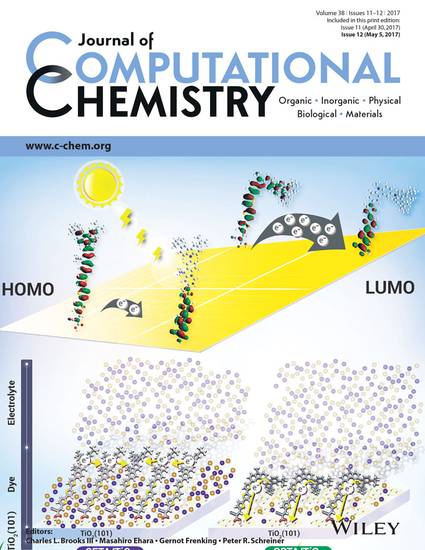
Article
Theoretical rationalization for reduced charge recombination in bulky carbazole‐based sensitizers in solar cells
Journal of Computational Chemistry
(2017)
Abstract
The search for greater efficiency in organic dye‐sensitized solar cells (DSCs) and in their perovskite cousins is greatly aided by a more complete understanding of the spectral and morphological properties of the photoactive layer. This investigation resolves a discrepancy in the observed photoconversion efficiency (PCE) of two closely related DSCs based on carbazole‐containing D–π–A organic sensitizers. Detailed theoretical characterization of the absorption spectra, dye adsorption on TiO2, and electronic couplings for charge separation and recombination permit a systematic determination of the origin of the difference in PCE. Although the two dyes produce similar spectral features, ground‐ and excited‐state density functional theory (DFT) simulations reveal that the dye with the bulkier donor group adsorbs more strongly to TiO2, experiences limited π–π aggregation, and is more resistant to loss of excitation energy via charge recombination on the dye. The effects of conformational flexibility on absorption spectra and on the electronic coupling between the bright exciton and charge‐transfer states are revealed to be substantial and are characterized through density‐functional tight‐binding (DFTB) molecular dynamics sampling. These simulations offer a mechanistic explanation for the superior open‐circuit voltage and short‐circuit current of the bulky‐donor dye sensitizer and provide theoretical justification of an important design feature for the pursuit of greater photocurrent efficiency in DSCs. © 2017 Wiley Periodicals, Inc.
Keywords
- Charge recombination,
- Solar cell,
- DFTB,
- Molecular dynamics,
- TD-DFT
Disciplines
Publication Date
May 5, 2017
DOI
10.1002/jcc.24751
Publisher Statement
© 2017 Wiley Periodicals, Inc.
Citation Information
Yaowarat Surakhot, Viktor Laszlo, Chirawat Chitpakdee, Vinich Promarak, et al.. "Theoretical rationalization for reduced charge recombination in bulky carbazole‐based sensitizers in solar cells" Journal of Computational Chemistry Vol. 38 Iss. 12 (2017) p. 901 - 909 Available at: http://works.bepress.com/tim-kowalczyk/1/